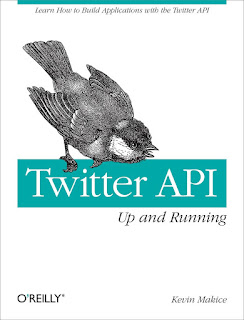Twitter API: Up and Running By Kevin Makice
Download
Introduction
How This Book Is Organized
This book introduces the Twitter API in the context of a greater community culture,
offering a suite of sample applications to help illustrate some key programming concepts.
Here’s a synopsis of what you’ll find:
Chapter 1, Hello Twitter
Gives you a comprehensive overview of the Twitter culture, including the history
of microblogging, the Fail Whale, the company business model, the API developer
community, and creative uses of Twitter.
Chapter 2, Twitter Applications
Reviews more than two dozen existing third-party Twitter web applications you
can use as inspiration for your own creations. The applications are grouped into
seven tools categories—Publishing, Information Stream, Appropriation, Search,
Aggregation, Statistics, and Follow Network tools—and each app is profiled with
a screenshot and a description of what it does.
Chapter 3, Web Programming Basics
Provides a comprehensive starter kit for XHTML, CSS, PHP, and MySQL. This
chapter is meant to be a primer for new programmers and a convenient reference
for more experienced programmers. It also offers some advice on what to look for
when searching for a web host to care for your new application.
Chapter 4, Meet the Twitter API
Gives the details on how to make requests of the Twitter API. Included in the
general explanation are format differences, HTTP methods and error codes, authentication,
and rate limits. This chapter contains a directory of all of the parameters
used by the API and a description of each of the 40 methods, grouped into
seven categories: Publishing, Information Stream, Follow Network, Communication,
Member Account, API Administration, and Search. It also includes a discussion
about security issues involving Basic Auth and a brief description of how to
use cURL to test the API.
Chapter 5, Meet the Output
Takes a look at what comes out of the API as a response from Twitter. The various
types of XML objects you will encounter—user, status, message, search, ID,response, and hash—are detailed with example output, explanations of the included
XML elements, and a list of methods that return that object.
Chapter 6, Application Setup
Discusses the things you need to do to get your web environment ready, including
creating a master Twitter account, making your MySQL database tables, creating
your stylesheet, and uploading custom functions to a directory outside the web
path. Each of the custom functions used in the sample applications is discussed in
detail, with a description of what it does and PHP code provided as examples.
Chapter 7, Sample Applications
Describes the web interfaces from the suite of sample applications. For each of the
seven applications, I’ll run you through how to use it and what it does, and then
we’ll look closely at the code. Included are suggestions for how to make this starter
code better.
Chapter 8, Automated Tasks
Describes the code for the programs from the suite of sample applications that run
in the background. It includes a brief explanation of what each of the five scripts
does and how the PHP code works.
Appendix
Provides a bare-bones look at the Twitter API, listing the method path, whether it
requires authentication, if it is charged against your rate limit, the HTTP method
type, and any required and optional parameters.
Home Api Development Twitter API: Up and Running

